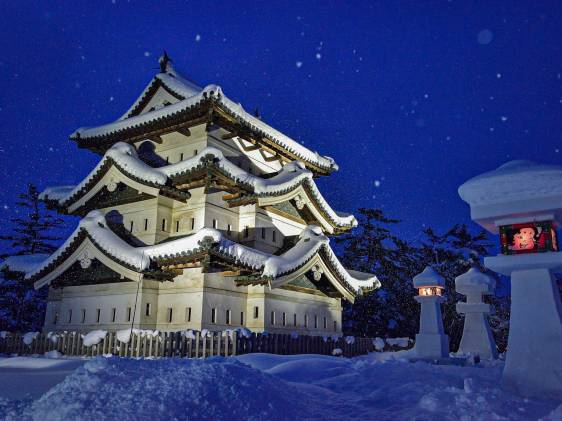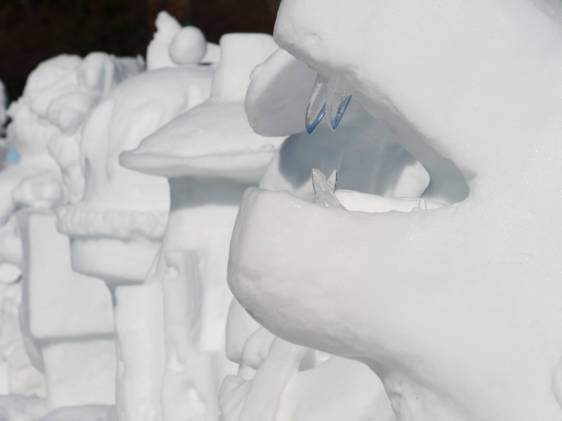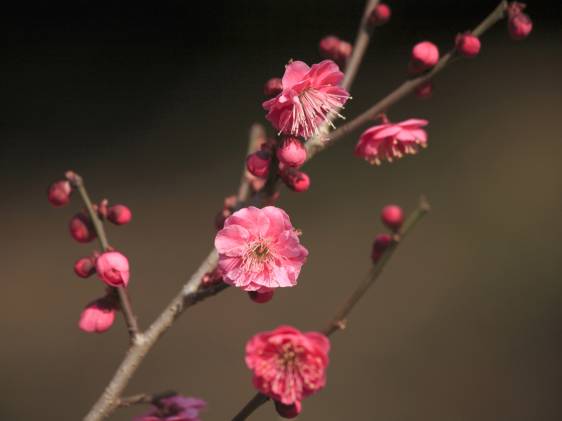Snow, fire, and even plum blossoms mean there’s plenty to see this month in Japan. The festivals are a pick-and-mix of purification rituals, seasonal celebrations, and playful family events.
February is a month filled with winter wonderlands, and locals are celebrating snow and saying goodbye to fiery demons. If it’s the snow festivals you’re after, see our article on the best winter festivals in Japan.
For events in Tokyo and the surrounding areas, visit our event listings on Tokyo Cheapo.
Kansai events
These are events in Kyoto, Osaka, Hyōgo, Mie, and the surrounding areas.
Yasaka Shrine Setsubun
KyotoAn annual celebration of the arrival of spring, Setsubun is an age-old ceremony held across Japan to drive evil spirits from the house. It’s common to see people dressed as demons being herded from homes and businesses by occupants throwing beans.
A great chance to see the maiko and geiko (geisha of Kyoto) without forking out terrifying amounts, this Setsubun ceremony is pretty special. The first day features dancing and bean-throwing, while the second has a lion dance, too.
Heian Jingu Setsubun
KyotoThis is one of the most well-known Setsubun celebrations in Kyoto and offers a cleansing ritual, an exorcism performance complete with evil oni (demons) and even maiko and geiko who throw beans into the crowd. The day ends with a fire ceremony, and while it will no doubt be busy, it’s worth the crowds.
Baikasai Plum Blossom Festival
KyotoA sign of the start of spring, the plum blossom transforms the already impressive Kitano Tenmangu Shrine into a seasonal treat. While the blossom will be around for a week or two, the festival day features a tea ceremony with apprentice geiko (Kyoto’s geisha) called maiko, but tickets are limited, so be there on time!
Dojima Yakushido Setsubun Omizukumi Festival
OsakaAt this Setsubun event, traditional prayer sticks are thrown into the fire in a Goma-daki ceremony.
Hirosaki Castle Snow-Lantern Festival
Hirosaki
Decorating the already impressive castle with over 200 lanterns, this event is perfect for a relaxing evening stroll in the snow (if there is such a thing). There will be snow sculptures and performances during the day, as well as a kids-only snow slide (disappointing, we know).
Shigisan Tiger Festival
NaraTraditionally known as the Month of the Tiger, it’s no surprise February has a whole festival centered around the striped beast. 50 tiger boys and girls parade with tiger shrines, accompanied by traditional taiko drumming and Japanese instruments. The children are all born in the Year of the Tiger, lending them their rightful roles.
Osaka Marathon
OsakaThe Osaka Marathon lets you see the city with a different atmosphere. One filled with cheering, sweating, and a winter’s glow. There will also be an Osaka Marathon Expo.
Kantō events
These are events in Ibaraki, Tochigi, and other areas surrounding Tokyo.
Yunishigawa Onsen Kamakura Festival
Yunishigawa Onsen (Nikkō)A snowy wonderland appears each winter in this quiet hot-spring town, as hundreds of small snow-houses are built. Illuminated on Friday, Saturday, and Sunday evenings for the one-month duration of the event, the kamakura (igloos) are a beautiful sight, and a barbecue inside one can even be arranged.
Hokkaidō events
These are events in Sapporo, Hakodate, and all the chilly areas on Japan’s northernmost island.
Sapporo Snow Festival
Sapporo
One of Japan’s most famous festivals, the Sapporo Snow Festival spans six days and is filled with food, snow, and sculptures. Huge creations are carefully crafted in Odori Park by international and Japanese sculptors, and you can find plenty of food trucks with warming food and drink to keep you going.
Noboribetsu Onsen “Naked Man” Festival
NoboribetsuOfficially called the Noboribetsu Onsen Hot Water Festival (Noboribetsu onsen yu matsuri), this unique festival takes place at the coldest time of year, when the last thing you want to be is naked (well, semi-naked) while running around at night and throwing water at each other.
Otaru Snow Light Path Festival
OtaruTimed to coincide with Sapporo’s giant winter festival, Otaru’s Snow Light Path (Otaru Yuki Akari no Michi — the awkward name is a direct translation) is on a much more intimate scale.
Abashiri Okhotsk Drift Ice Festival
AbashiriDeep in the snowdrifts of northern Hokkaido, this snow festival has towering sculptures that are illuminated at night. There are family games, a selection of food and drink stalls to choose from, and plenty of creations to pose with; just dress warm!
Tōhoku events
These are events in Fukushima, Sendai, and the surrounding areas.
Zaō Snow Monster Festival
Zaō OnsenThis is a chance to see the most unusual natural snow creations of the season. The “monsters” of Miyagi are illuminated every day, and there is also a parade of professionals and familiar characters skiing with LED lights.
Lake Towada Winter Story of Light
Lake TowadaA winter wonderland appears beside the shores of Lake Towada for around three weeks every February. There is a short fireworks display (about 10 minutes) each night from 7:30 p.m., as well as illuminations to enjoy.
Tadami Snow Festival
FukushimaA small town with a reputation for its annual snow festival, Tadami certainly knows how to make the most of the seasonal weather. A great local alternative to the Sapporo Snow Festival, this one has sculptures, carvings, and taiko performances, as well as fireworks.
Kamihinokinai Paper Balloon Festival
AkitaAn annual event with a long but unclear history, this festival sees dozens of large paper balloons released into the sky. Decorated with traditional designs, the larger balloons are truly amazing, while the smaller ones are covered in wishes by locals and visitors.
Kasedori Festival
YamagataAnother of the more unusual Japanese winter festivals, this one involves local men dressed in straw coats, pretending to be birds — giving the event its name. The tradition originated in the 17th century. It begins in front of the Kaminoyama Castle: the dancing straw men are doused in cold water, and are gradually herded into the city for some warming sake.
Namahage Sedo Festival
AkitaThe Namahage Sedo Festival involves demons, bonfires, and a whole load of screaming children. The festival is terrifying, to say the least. If you’re in town, be sure to go to the Namahagekan Museum to see a variety of the costumes used.
| At the door: ¥1,000 | ||
Yokote Kamakura Snow Festival
Akita
Held for over 400 years, this festival has perfected the art of kamakura igloos, and each has a small altar with rice and wine offerings to the gods.
Uesugi Snow Lantern Festival
Yamagata200 snow lanterns and around 1000 snow caves are lit up in Matsugasaki Park. The light display is different from your usual yellow lanterns, and includes different shapes and bright colors. There will be plenty of food stalls and stage performances, including musical acts and mascots.
Hiroshima events
These are events in Hiroshima, Okayama, Tottori, Yamaguchi, and surrounding areas.
Saidai-ji Eyo Hadaka Festival
Okayama
Another of the famed naked festivals of Japan, this event has a history going back 500 years — so you can be sure the nakedness is cultural. Watch over 9,000 participants compete to catch the two lucky sticks called shingi, as well as bundled willow strips, thrown to the crowds by priests.
Chūbu events
These are events in Nagano, Aichi, Fukui, and surrounding areas.
Kawazu Cherry Blossom Festival
IzuKawazu cherry blossoms (also known as Kawazu-zakura) are early-blooming sakura that make their appearance around a month earlier than the more common Somei Yoshino cherry blossom variety.
Katsuyama Sagicho Matsuri
FukuiCentered around the traditional Dondo-yaki ceremony held in the New Year, this festival takes place on the banks of the Kuzuryu River. New Year’s ornaments are burned while local artists perform on elevated wooden stages that are carried around the city. The traditional fire festival has been held for the last 300 years, and always draws large crowds.
Souriike Plum Blossom Festival
AichiSouriike is a large pond in Chita City. On the edge of the pond is Souri-midoritohana-no-fureai Park, home to 5,100 individual plum trees and 25 different varieties. The best time to see them is from mid-February until mid-March.
While we do our best to ensure it’s correct, information is subject to change. Post first published in January 2018. Last updated in January 2025.
Get the best Japan Cheapo hacks direct to your inbox
-
 Getting the Most Out of Your Trip to Universal Studios Japan
Getting the Most Out of Your Trip to Universal Studios Japan -
 12 Favorite Things To Do in Osaka
12 Favorite Things To Do in Osaka -
 How To Spend a Week in Beautiful Hokuriku
How To Spend a Week in Beautiful Hokuriku -
 Awazu Onsen: Cave Temples, Craft Villages and Ancient Ryokan
Awazu Onsen: Cave Temples, Craft Villages and Ancient Ryokan -
 Touring Abandoned Hashima Island (Gunkanjima or Battleship Island)
Touring Abandoned Hashima Island (Gunkanjima or Battleship Island) -
 Sail the Ocean Blue: Traveling with the Japan Ferry Pass 21
Sail the Ocean Blue: Traveling with the Japan Ferry Pass 21










































